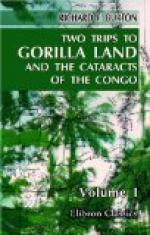That interesting anthropoid’s career after death was one series of misfortunes, ending with being stuffed for the British Museum. My factotum sat up half the night skinning, but it was his first coup d’essai. In a climate like the Gaboon, especially during the rains, we should have turned the pelt “hairy side in,” filled it with cotton to prevent shrinking, and, after painting on arsenic, have exposed it to the sun: better still, we should have placed it on a scaffolding, like a defunct Congo-man, over a slow and smoky fire, and thus the fatty matter which abounds in the integuments would have been removed. The phalanges of the hands and feet, after being clean-scraped, were restored to their places, and wrapped with thin layers of arsenicated cotton, as is done to small animals, yet on the seventh day decomposition set in; it was found necessary to unsew the skin, and again to turn it inside out. The bones ought to have been removed, and not replaced till the coat was thoroughly dry. The skinned spoils were placed upon an ant-hill; a practice which recalls to mind the skeleton deer prepared by the emmets of the Hartz Forest, which taught Oken that the skull is(?) expanded vertebrae. We did not know that half-starved dogs and “drivers” will not respect even arsenical soap. The consequence of exposing the skeleton upon an ant-hill, where it ought to have been neatly cleaned during a night, was that the “Pariah” curs carried off sundry ribs, and the “parva magni formica laboris” took the trouble to devour the skin of a foot. Worse still: the skull, the brain, and the delicate members had been headed up in a breaker of trade rum, which was not changed till the seventh day. It was directed to an eminent member of the old Anthropological Society, and the most interesting parts arrived, I believe, soft, pulpy, and utterly useless. The subject seems to have been too sore for mentioning —at least, I never heard of it again.
The late Dr. John Edward Gray, of the British Museum, called this Nchigo Mpolo, from its bear-like masses of breast-pile, the “hairy Chimpanzee” (Troglodytes vellerosus). After my return home I paid it a visit, and could only think that the hirsute one was considerably “mutatus ab illo.” The colour had changed, and the broad-chested, square-framed, pot-bellied, and portly old bully-boy of the woods had become a wretched pigeon-breasted, lean-flanked, shrunk-linibed, hungry-looking beggar. It is a lesson to fill out the skin, even with bran or straw, if there be nothing better—anything, in fact, is preferable to allowing the shrinkage which ends in this wretched caricature.




